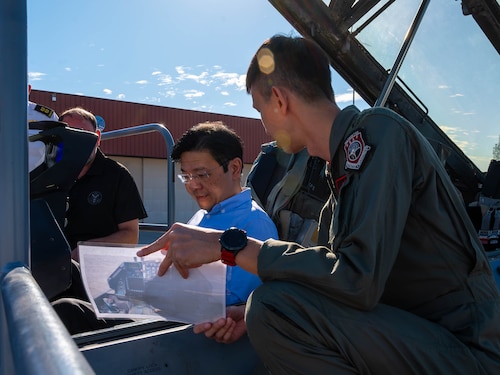The Air Force Installation and Mission Support Center is leading a more than $500 million facilities construction project to facilitate expeditionary skills training and military pilot training at Ebbing Air National Guard Base, Arkansas.
In line with the National Defense Strategy, focus on collaboration between the U.S. and its allies and partners on shared objectives, the project will establish a permanent F-35 Lightning II training center for military pilots from Singapore and NATO countries who purchase the weapon systems under the Foreign Military Sales program. Ebbing ANGB will become the new location for the 425th Fighter Squadron, a Republic of Singapore air force F-16 Fighting Falcon training unit, currently based at Luke Air Force Base, Arizona.
"This project will provide additional capacity to allow training for more of our international partners than current facilities allow," said Col. Adam T. Rice, Air Education and Training Command lead for Ebbing Field integration and synchronization. "The mutually beneficial FMS mission increases interoperability and enhances the long-term relationships between the U.S. military and our allies and partners."
As part of the expansive multi-year effort, Ebbing Field will also host missions intended to enhance U.S. national security by providing additional resources for Air Force agile combat employment and large force employment training and exercises, U.S. Air Force F-35 pilot qualification and upgrade training while also serving as a standing aircraft emergency divert location.
"ACE shifts operations from centralized physical infrastructures to a network of smaller, dispersed locations that can complicate adversary planning, improve resilience, and provide more options for joint force commanders," Rice said. "Ebbing will provide an excellent area for us to train the force on how to conduct ACE operations in support of deterrence, crisis response or other operations, while at the same time also supporting our U.S. F-35 pilot training mission."
In June, the Air Force Civil Engineer Center partnered with the U.S. Army Corps of Engineers, the 97th Contracting Squadron at Altus AFB, Oklahoma, and the 772nd Enterprise Sourcing Squadron from AFIMSC, to award more than $27 million in appropriated funds for planning and design of construction. The work includes design on four military construction projects, construction of eight facility renovation projects and installation of 10 relocatable facilities. AFCEC, a primary subordinate unit of AFIMSC, is the design and construction execution manager of the effort planned to be complete in late 2028.
"AFCEC is partnering with the Air Education and Training Command to deliver timely and cost-effective design and construction solutions required to support operations at Ebbing Field," said Col. George Nichols, deputy director of AFCEC's Facility Engineering Directorate. "It's the most hybrid beddown I've been a part of in 23 years: multiple active-duty missions on an Air National Guard base."
The Arkansas installation officially became the location for the foreign pilot training mission in March when the secretary of the Air Force signed the project's Record of Decision after completing the requirements within the National Environmental Protection Act and the Environmental Impact Statement. AFCEC's NEPA team partnered with Ebbing ANGB and the National Guard Bureau to conduct the environmental impact analysis that led to the decision.
"The EIA gave us the green light to move forward with the construction phase and turn Ebbing into an Air Force foreign mission training center," Nichols said. "Central location, existing fighter aircraft infrastructure, and range and airspace were decisive factors in making Fort Smith the official choice to host the FMS mission."
Other key organizations engaged in execution include the host 188th Wing at Fort Smith and AFIMSC's Detachment 7 providing installation and mission support for AETC, the parent of the training mission at Ebbing ANGB.
Ebbing ANGB will require new infrastructure, including a mix of military construction and facility renovation projects, to reach completion. AFCEC plans to use relocatable facilities to ensure the base is ready for initial operational capabilities in 2024, until permanent infrastructure is in place.
"It is a complex and large program that necessitates careful planning and construction of different facilities to line up with when the different countries will arrive for training," said John Ahern, an AFCEC program manager. "Because we can't build that quick, we'll be leasing relocatable facilities to ensure the mission starts while MILCON construction is completed."
Working hand-in-hand with multiple Department of Defense stakeholders, AFCEC is making steady progress with planning, design, and construction activities to ultimately accommodate 24 F-35 aircraft from the various nations and 12 Singapore air force F-16s.
Most facilities supporting the F-35 FMS aircraft will be new MILCON construction while beddown of the F-16s will require renovation and modernization of current infrastructure, Ahern said.
"A program of this magnitude on a constricted timeline shows how significant partnerships are to meet mission requirements and execute on time and within budget," Nichols said. "We can't succeed without the strong collaboration and partnership we have and utilizing all acquisition tools in our toolbox. Whether it's managing the funds or awarding projects, we work as one team, across almost every AFCEC directorate, AFIMSC Resource Management and legal support, contracting agencies, and multiple USACE districts, to make this happen."
Foreign Military Sales, overseen and directed by the Defense Security Cooperation Agency, is a security assistance program authorized by the Arms Export Control Act. The act allows the U.S. to sell defense equipment, conduct training, and provide services to a foreign country when the president deems that doing so will strengthen U.S. national security and promote world peace, according to the DSCA website.







